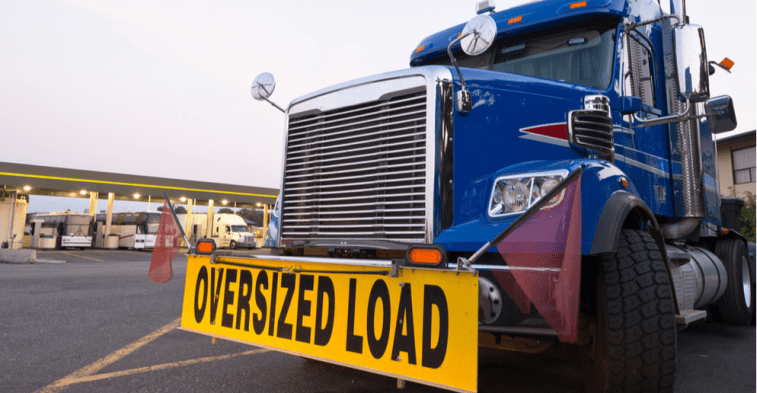6 Safety Tips for Transporting Oversized Loads
Stepping behind the wheel of a transport vehicle is dangerous enough, but when oversized loads are added to the mix, the risks are exponentially increased. Hauling these, whether across long or short distances, is no joke. It’s difficult and stressful, and there are many elements to consider, including traffic, road hazards and weather conditions.
That’s why it’s important that every driver understands, and is armed with, some safety tips to improve the experience. Here’s what every truck operator should know before hitting the highway with an oversized load.
1. Plan the Route Ahead of Time
Planning the route is a no-brainer, and modern technologies can be used to do it smarter and better. Logistics and route-planning tools can be used to research traffic, hazards, weather conditions, construction and any other encounters one might come across on the open road. Most importantly, drivers should always have a set of contingencies handy that allows them to choose alternate routes or roadways because there’s no telling what may happen.
Whether it’s the primary choice or an alternative, every route plan should include information about travel times, delays, fueling locations, and break spots. It’s important to think about every possible factor when planning the route. Not having a stringent refueling plan in place can balloon transportation costs, as drivers are forced to go out of their way or choose fueling stations that are less than ideal or overpriced.
2. Know the Weather
It doesn’t matter whether drivers use their smartphones or listen to the radio — they should always have a beat on the local weather and any upcoming changes. The entire forecast should be referenced and recorded before the drive. Any updates or changes should also be monitored throughout the journey. Some loads cannot be exposed to inclement weather, so it’s vital to avoid rainy, overcast or muggy areas.
Hauling oversized loads should never happen in extreme weather conditions, except in rare circumstances, such as a major emergency. If possible, find a rest stop to wait out the storm and hit the road when it’s safe to travel again.
3. Reference the Laws
There are rules and regulations about hauling oversized loads or items. Drivers and their sponsors must abide by those laws at all times. Nearly every state, province, and country has custom and defined dimensions for what constitutes an oversized load. Most describe it as anything wider than 8.5 feet, which takes up a substantial portion of the driving or travel lanes on roadways. Weight and height limitations may also apply, and it’s up to the drivers to know them.
Furthermore, hauling oversized loads requires a permit, which details the origin of the shipment and its destination. Driving without one can result in severe fines and sometimes other penalties and may even come with a license suspension for the driver. It’s important to keep all documentation updated before, during and after a haul.
4. Use the Right Securement
When hauling loads of any size, it’s critical to keep the pieces, items or components locked down and secured. There are many different types of fastening devices, from ropes and straps to friction mats and binders. They’re not always interchangeable, and sometimes those devices are not ideal for certain loads or gear. It’s up to the drivers to know which securement tools are best for a particular load. Using the wrong devices can have major repercussions and may or may not lead to the heavy load falling off the trailer or transport.
What’s more, those devices should be inspected regularly to ensure they’re in proper working order and have not been damaged in any way. This should be done before and after a haul, and any broken or failing items should be replaced right away.
5. Drive Defensively
It’s important to drive defensively and safely when hauling oversized loads. This is not to be confused with going slowly. It can seem safer to maintain slower speeds, but that’s a misconception, more so on highways and major roadways. It’s best to drive at the recommended speed limit and to remain in lanes that are expressly labeled for trucks — sometimes, there are dedicated lanes you must stay in with an oversized haul.
Drivers should make a habit of checking their speed regularly during a trip. They should also maintain a safe stopping distance that’s far enough away from vehicles and other cars nearby.
6. Proactive Maintenance
The last thing anyone wants during an oversized haul is for the truck to malfunction or break down. It’s important to carry out proactive maintenance on a vehicle or fleet before a big trip to prevent that from happening. Fluids should be topped up and monitored, the tires should be checked, spare parts and gear should be added to the truck, and basic maintenance should be handled.
Another facet of this is to have a service plan at the ready if and when something does happen. Drivers should always know who to call and where to go to get their vehicles serviced or where the much-needed support is going to come from. That can be something researched when building the initial route plan, or it can be information that’s gathered and recorded over time. Either way, every driver should know what to do if their truck breaks down.
Be Safe When Hauling Oversized Loads
Proper planning is crucial to a successful trip. It’s vital to plan the route and situational factors, research local weather conditions and work around them, drive defensively, and use the correct securements. It’s also important to know and understand the laws and keep all permits and documentation up to date. Proactive maintenance should be followed to keep the trucks or fleet in tip-top shape. Every driver should have a plan of action if and when their vehicle breaks down or malfunctions.
By knowing and adhering to these safety guidelines, drivers can secure their health and success while hauling oversized loads. That assurance alone is worth its weight in gold.
__________________________________________________________________
Emily Newton is an industrial journalist. As Editor-in-Chief of Revolutionized, she regularly covers how technology is changing the industry.





Leave a Reply